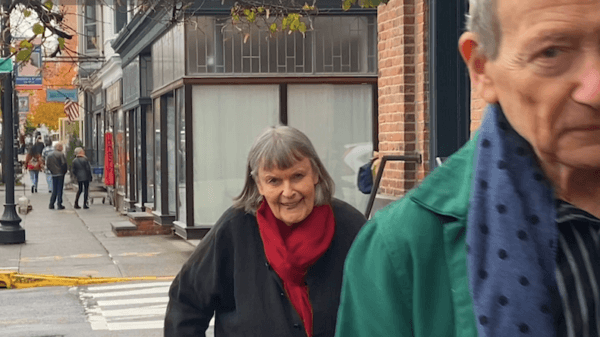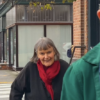From around 1870 to the turn of the century, opulent trade cards were a vibrant way to advertise local businesses. These cards, with their intricate designs and bold messaging, offer a fascinating glimpse into the commercial landscape of the Gilded Age. In this article, we delve into trade cards collected by Robert Courtwright, now archived by the Historical Society of the Nyacks. While not all the cards are explicitly tied to Christmas, they capture the festive spirit of the season and reflect the wide array of products available during that era.

The Rise of Trade Cards
Trade cards, printed advertisements often featuring colorful artwork on the front and business details on the back, surged in popularity with the advent of lithography and multi-color printing. Emerging around 1876, these cards became a staple of advertising through the end of the 19th century. They were used to announce new businesses, services, or products and to distinguish one retailer from another.
These cards also served as a counterpart to carte de visite — photographic calling cards used in social visits. Some trade cards featured cooperative advertising, where a product’s manufacturer partnered with local retailers to promote their goods.
Nyack’s Trade Cards: A Window into the Past
Trade cards provide a unique perspective on Nyack’s bustling business scene during the Gilded Age. Local stores often adopted a personal touch, with businesses named after their owners, such as Sturtevant’s Stationery. Addresses were sometimes vague, referencing landmarks like “near the post office” or “across from the bank.” The cards themselves ranged in style, depicting everything from elegant, fashionable women to nostalgic nature scenes and humorous cartoons. Unfortunately, many also included offensive racial and gender stereotypes, which have been left intact in this discussion to reflect the attitudes of the time.

Nyack Shops During the Gilded Age
The mix of businesses in Nyack during this period was notably different from today. At one time, six apothecaries operated within a two-block stretch on Broadway. Numerous dry goods stores thrived, each catering to specific needs. Garrett Hopper, Edward Hopper’s father, for example, was known for his semi-annual underwear sales, while other shops specialized in corsets or furs. In 1892, the opening of Harrison & Daley’s department store on Main Street (later Woolworth’s) marked a shift in retail, consolidating clothing, toys, and home furnishings under one roof.

Groceries were abundant, but their offerings were limited compared to modern supermarkets. Separate stores sold meat, fish, fruit, ice cream, and candy. Each shop carved out its niche in the village’s commercial ecosystem.
Blauvelt Enterprises
The Blauvelt name was a fixture in Gilded Age Nyack’s business landscape.
- George S. Blauvelt ran a livery,
- Cornelius Blauvelt partnered with Mr. Morrill in real estate and insurance,
- James H. Blauvelt operated a blacksmith shop,
- Edgar E. Blauvelt owned a hardware store,
- Dr. James Blauvelt served as a dentist,
- David Blauvelt managed the Nyack Steam Laundry (one of the few businesses named for its function),
- John D. Blauvelt ran an apothecary,
- William O. Blauvelt operated a “New York Store” more commonly known as a dry good store
These businesses highlighted the entrepreneurial spirit of the Blauvelt family and their lasting impact on the local economy.


Two Blauvelt newspaper ads
Highlights of Nyack’s Gilded Age Retailers
Apothecaries and Health Products
Apothecaries played a vital role in community health during the Gilded Age. Customers relied on them for advice and patent medicines. At one point, six apothecaries operated on Broadway. John D. Blauvelt’s pharmacy, initially located on South Broadway, later moved to Main Street, where the current Koblin’s Pharmacy stands.






Blauvelt Apothecary (DePew Place)





Barrett Apothecary (Commercial Block)


DeGraff Apothecary (South Broadway)
Dry Goods and Clothing Stores
Smith & Quidors, a staple for boys’ and men’s clothing, operated on North Broadway from 1883 until the 1960s, when it became Zabriskie’s. Abram Merritt’s dry goods store, located at the southeast corner of Main and Broadway, was later succeeded by Harrison & Daley’s department store. William and John Blauvelt both ran dry goods stores, with John’s located in the Voorhis Building across from Smith & Quidors and William’s in the Commercial Block just south of Main Street..

Smith & Quidor’s




John H. Blauvelt Dry Goods (Voorhis Building)



Charles Ross, Broadway


William Blauvelt, Commercial Block


Farr Millinery, Onderdonk Place


Abram Merritt, southeast corner Main & Broadway


Cranston & Ackerman, southwest corner of Main and Broadway
Local Goods-Shoemaking and Soap
Nyack earned the nickname “Shoe Town” during the Gilded Age, transitioning from home-based shoemaking to industrial production. William Best’s store on Main Street sold Morrow shoes, manufactured locally at a plant on Castle Heights Avenue. Henry Doersch, a brother of a shoemaker, had a shoe store on Broadway. Meanwhile, Peerless Soap, founded in 1879, diversified into dyes and paints before the factory, then called the Aniline Dye Company, was destroyed by an explosion and fire in 1919.


Doersch shoes

Piano and Organ Stores
Middle-class homes often aspired to own a piano or organ, and Nyack accommodated this demand with several manufacturers and retailers. Sumner Sturtevant operated the largest factory, while Peek & Craig, D.E. Matthews, and Tallman offered retail options. The Historical Society of the Nyacks still houses a locally made Tallman piano


Grocers
Nyack was once loaded with downtown grocers. Stilwell’s, C. C. Powell, and Callahan Brothers, all located in downtown. produced trade cards. Lyeth operated a grocery and other goods in his store in Upper Nyack, now immortalized in an Edward Hopper painting entitled Seven A.M. In West Nyack, known then as the Nyack Turnpike Station or Mount Moor, Ben Smith, like Lyeth, offered groceries and provisions including medicines, grain, and paints.

C.C. Powell


Ben Smith, West Nayck


Stilwell’s, Union Hall, 50 Main Street

St. Nicholas Bakery, Main Street

Van Houten, Corner of Church and Broadway


George Lyeth, Upper Nyack

Stationery Stores and Art Supplies
In addition to writing material, stationery stores sold art materials, sheet music, and toys at Christmas. W, W. Hinton, located across from the bank, and later in Depew Place, included Japanese goods, and children’s toys in their trade card. Hinton’s Stationery was Edward Hopper’s go-to shop for art supplies. While helping at his father’s store, likely visited Hinton’s, just a few doors south on Broadway. Sturtevant’s on Broadway specialized in books and music.


Sturtevant’s, Broadway


W.W. Hinton, South Broadway (opposite bank)
Jewelry and Luxury Items
William Collins dominated Nyack’s early jewelry market, followed by Ackerman, who set up shop on South Broadway. Jewelry stores of the time catered to the growing middle-class desire for luxury and refinement.

Collins, Jeweler, Main at Cedar Street


Ackerman, Jeweler
Ice Cream and Confectioneries
Ice cream and candy shops flourished in Nyack. Schmitt’s on Main Street, Sloat’s on Broadway, and George Kahlenberg’s stationery and confectionery shop were popular destinations for holiday treats. Banks Johnson, a confectioner and organist, was also one of the YMCA’s founders in 1889.

Banks Johnson, Main Street

Sloat’s, Broadway

Kallenberg, Broadway

Newell’s Ice Cream, Broadway (across from the bank)
Liquor, Horses, & Hardware


New York House, Main near Franklin

Van Houten Staples, Church Street at Liberty Street

Lessels Hardware, Voorhis Building
Reflecting on a Bygone Era
Trade cards offer a vivid snapshot of Nyack’s vibrant retail scene during the Gilded Age. They highlight not only the variety of businesses but also the commercial opulence and social dynamics of the time. While some cards reflect troubling stereotypes, they serve as historical artifacts that remind us of the cultural context of their era.
The collection preserved by the Historical Society of the Nyacks provides a unique lens through which we can explore the village’s past, illustrating how much has changed while preserving the spirit of a bustling, thriving community.
Mike Hays lived in the Nyacks for 38-years. He worked for McGraw-Hill Education in New York City for many years. Hays serves as President of the Historical Society of the Nyacks, Vice-President of the Edward Hopper House Museum & Study Center, and Upper Nyack Historian. . Married to Bernie Richey, he enjoys cycling and winters in Florida. You can follow him on Instagram as UpperNyackMike.
Editor’s note: This article is sponsored by Sun River Health and Ellis Sotheby’s International Realty. Sun River Health is a network of 43 Federally Qualified Health Centers (FQHCs) providing primary, dental, pediatric, OB-GYN, and behavioral health care to over 245,000 patients annually. Ellis Sotheby’s International Realty is the lower Hudson Valley’s Leader in Luxury. Located in the charming Hudson River village of Nyack, approximately 22 miles from New York City. Our agents are passionate about listing and selling extraordinary properties in the Lower Hudson Valley, including Rockland and Orange Counties, New York.









